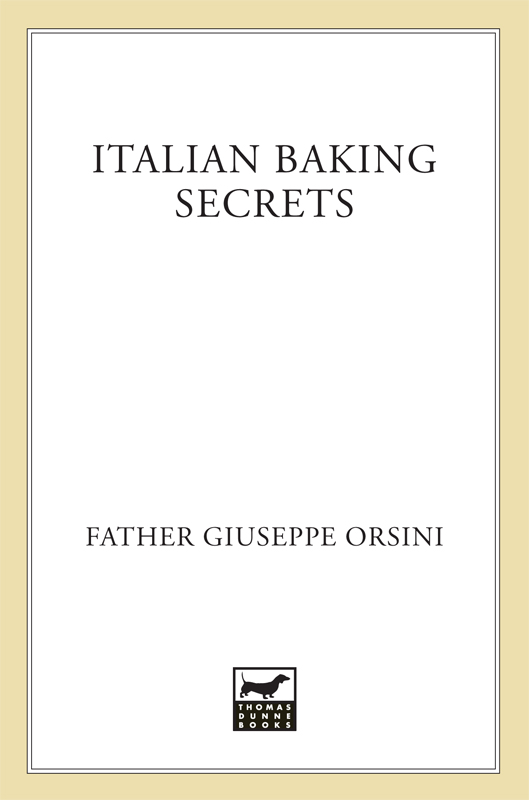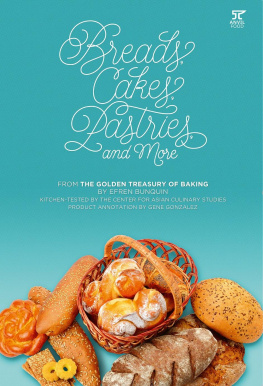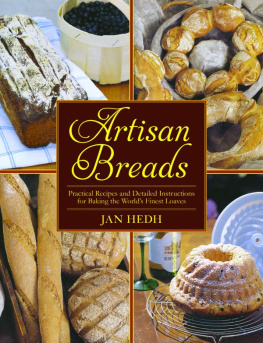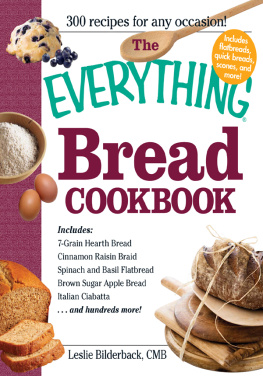Father Giuseppe Orsini - Italian Baking Secrets
Here you can read online Father Giuseppe Orsini - Italian Baking Secrets full text of the book (entire story) in english for free. Download pdf and epub, get meaning, cover and reviews about this ebook. City: New York, year: 2007, publisher: St. Martins Press;Thomas Dunne Books, genre: Home and family. Description of the work, (preface) as well as reviews are available. Best literature library LitArk.com created for fans of good reading and offers a wide selection of genres:
Romance novel
Science fiction
Adventure
Detective
Science
History
Home and family
Prose
Art
Politics
Computer
Non-fiction
Religion
Business
Children
Humor
Choose a favorite category and find really read worthwhile books. Enjoy immersion in the world of imagination, feel the emotions of the characters or learn something new for yourself, make an fascinating discovery.

- Book:Italian Baking Secrets
- Author:
- Publisher:St. Martins Press;Thomas Dunne Books
- Genre:
- Year:2007
- City:New York
- Rating:5 / 5
- Favourites:Add to favourites
- Your mark:
- 100
- 1
- 2
- 3
- 4
- 5
Italian Baking Secrets: summary, description and annotation
We offer to read an annotation, description, summary or preface (depends on what the author of the book "Italian Baking Secrets" wrote himself). If you haven't found the necessary information about the book — write in the comments, we will try to find it.
Italian Baking Secrets — read online for free the complete book (whole text) full work
Below is the text of the book, divided by pages. System saving the place of the last page read, allows you to conveniently read the book "Italian Baking Secrets" online for free, without having to search again every time where you left off. Put a bookmark, and you can go to the page where you finished reading at any time.
Font size:
Interval:
Bookmark:


The author and publisher have provided this e-book to you for your personal use only. You may not make this e-book publicly available in any way. Copyright infringement is against the law. If you believe the copy of this e-book you are reading infringes on the authors copyright, please notify the publisher at: us.macmillanusa.com/piracy.
Contents
Acknowledgments
Ruth Cavin, my editor, and Toni Plummer, my assistant editor.
Thomas Dunne, my friend and publisher.
Joseph Rinaldi and Peter Horan, my friends and publicists.
To Calabria and Sicily, the fertile soil of my family roots.
To my nieces Carmel O. Ferrante, Jo-Anne Martin, and Inez C. Orsini, who generously shared their recipes for this book.
To all of my friends and family in Italy, who gave me their special recipes for this book.
I must mention Vincenzo Calderone, the only master Italian baker in Bayonne, who gave me many secret tips about Italian baking that I could pass on to my readers.
Finally and foremost, to my God, who inspires me always to share his truth through my books.
A Brief History of Bread
There are no existing legends or documents that tell us when man began making bread to use in his diet. We know that in prehistory, cultivation of various grains began over eight thousand years before Christ. Most probably, the first grain used to make bread was barley. The use of millet, a more nutritious grain for breads, came next. In Africa and the hot-dry regions of southern Asia, the use of millet was widespread until the end of the Neolithic period. Rye and spelt were used in the Bronze Age as evidenced by the presence of these grains in the caves of that era. The cultivation of wheat was widespread in Western Europe around the fourth century B . C . This indicates that wheat bread is among the most ancient of foodstuffs.
The first step toward bread making began when people began to grind wheat and other grains between two flat rocks. This coarse flour was mixed with water and eaten as cold cereal. When fire was discovered, the grains were toasted to make them tastier and more digestible. When this flour was mixed with water, the dough was cooked on hot flat stones. Thus, the first flat breads came into use. The ancient Egyptians invented the first ovens to bake their flat breads.
The next revolutionary step in bread making was the discovery of yeast. Scientists and archaeologists cannot fix the date when natural fermentation was first found; they guess that someone threw a handful of dough into a dark and warm corner of a cave, forgot about it, and found it days later bubbling with life and smelling sour. This brave unknown person baked the dough anyway, and so the first loaf of leavened bread came into existence. The ancient Egyptians were the first to learn, through experiments, how to control fermentation and became the first bakers of leavened bread in the ancient world.
During the period of Greek civilization, leavened bread baking reached new heights. The ancient Greek bread bakers made fifty different types of loaves. The Romans conquest of Greece brought bread into the Roman Empire. Bread became the staff of life as evidenced in the building of public flour mills and ovens throughout the Roman Empire. It was the Romans who invented flour mills, where grains were ground in between giant slabs of granite, and thus produced finer grades of flour.
It was near the end of the Roman Empire, when the emperors decreed free bread and entertainment for Roman citizens. Panem et Circenses, bread and circuses, were an effort to maintain a semblance of Roman law among the increasing disorder of the declining Roman Empire.
However, the glorious Empire fell when invaded by the barbarian tribes of France and Germany. This was the beginning of the Middle Ages of European history, when the monks in their monasteries not only preserved great classic literature but the art and science of bread making. The monks began wine making later in history.
Food history is as important to study as an integral element of the history of mankind as are wars, philosophies, theologies, and social movements. Without food there would be no history at all.
Bread in Italy
Bread in Italy is rough country loaves with thick chewy crusts and flat disks of focaccia seasoned with the wild herbs of the fields. Their tastes and shapes are fragrant reminders of a tradition of baking that is older than the Roman monuments and Romanesque cathedrals that we travel to Europe to see. These breads are expressions of an earthy culture that still talks about its most fundamental experiences in terms of bread. In Italy, a down-to-earth man with a real heart of gold is described as buono come il pane good, like bread. When Americans talk about being direct and straightforward, we say were calling a spade a spade, but Italians say pane al pane e vino al vino, calling bread bread and wine wine. Bread gives us real glimpses into the complex and fascinating history of all the regions of the country. Italy wasnt even even united until a little over a hundred years ago, so many of the roots have remained a little more exposed than might be true elsewhere. All the rivalries and bloody battles between neighboring cities and regions brought the inhabitants an intense pride. So just as each village and city had its own bell tower looking over its own fraction of countryside, ready to call citizens to arms and alert them to danger, their breads expressed a passionate attachment to local customs and ingredients.
Bread is so fundamental to everyday eating that the Italians are forever using the word companatico , an all-purpose term for what one eats with bread. Whats for lunch? Pane e companatico bread and something that goes with it. And bread is such a basic part of life that while there are no cookbooks devoted to baking bread at home, many recipes begin Take 500 grams of bread dough that youve bought from your baker. Pizzas , focacce, enriched breads, and holiday breads often begin just that way.
Each day in Italy, more than thirty-five thousand bakers rise early to knead their dough and shape their loaves, and of that number 90 percent are artisan bakers, working on a small scale and dedicated to keeping a family and regional tradition alive. They are preserving the past by making it a living part of the present, but they are also showing the bakers dazzling imagination, producing new wave breads that turn the luscious provender of the vines and fields into tantalizing loaves.
They have taken the olive paste of Liguria, made from the first crushing of salty, aromatic olives grown near the sea, and incorporated it into a bread. They have taken pesto and sweet peppers and tomatoes dried by the sun under a dappled screen of latticework arbors: use the humble potato and the most expensive aged cheeses; they have taken dark grains that once belonged to a peasant culture and given them new companions and shapes to make a range of breads that appeal to the Italian passion for fantasy, in the most inventive and tantalizing tastes imaginable.
Life without bread is inconceivable in Italy, and yet if I had decided to write this book twenty years ago, it would have been an elegy, a bittersweet testament to breads of another time. In the 1950s and 1960s, massive companies took over the bread baking of Italy, turning out airy white loaves like the spongy, cottony slices Americans know from our own supermarket shelves, and threatening to homogenize a tradition of breads, pastries, cookies, and pizzas that were once the culinary equivalent of Italys numerous dialects. Gone were the indigenous specialties. The tastes and flavors of the past were interred by high-speed rollers that milled grain to a bland, highly refined flour without texture or nutrients, and by huge machines that mixed and kneaded faster than the human eye could seeby automation that removed the human touch from the most basic of all human food. Suddenly, giant Italian companies were making deals with American consortia to produce biscuits and crackers by the millions to be eaten instead of bread. They were replacing grissini, the archetypal artisan-made bread stick, with pale little batons all the same color and width and length, extruded from the dies of a machine. Gone were the knobby thick bread sticks whose length was determined by the span of the bakers arms. Blandness suddenly ruled, leaving the centuries-old tradition conquered, as one writer puts it, by the imperialism of city bread.
Font size:
Interval:
Bookmark:
Similar books «Italian Baking Secrets»
Look at similar books to Italian Baking Secrets. We have selected literature similar in name and meaning in the hope of providing readers with more options to find new, interesting, not yet read works.
Discussion, reviews of the book Italian Baking Secrets and just readers' own opinions. Leave your comments, write what you think about the work, its meaning or the main characters. Specify what exactly you liked and what you didn't like, and why you think so.






